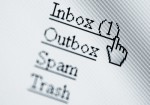As you are spring cleaning your office you have probably forgotten an important place: your inbox. When emails pile up they can get overwhelming and make looking at your account seem like a terrible chore. Take control of your inbox with these five steps to regain some email zen:
1. Turn off notifications
It is really distracting to constantly have a pop-up notification every time you get an email. Try changing your account settings so you don’t receive notifications. Instead, focus on the task at hand, and when you are done you can check your emails. If you’re concerned you’ll miss out on something urgent, be sure to tell people who might be sending you messages to mark them as important if necessary. You can change you settings so you are only notified of emails that have been marked “urgent” or “important.” That way, you won’t miss anything.
2. Delete old messages
It can be tempting to keep messages for months in case you end up needing them. Instead of cluttering up your inbox with emails you may or may not eventually return to, file away important information in a Word document. This will allow you to delete the email but still keep the information. You can also designate a file specifically for emails that you are unsure about and return to it at a later date to delete messages you didn’t end up needing.
3. Unsubscribe from junk
A good portion of many inboxes is made up of promotional mailings. A lot of stores offer a discount on your first purchase if you sign up for their newsletter, and it’s easy to click yes and then regret it later on. Instead of ignoring or deleting these emails on a daily basis, chose to unsubscribe from them. Most mail of this nature has an unsubscribe link at the bottom of the message. If it doesn’t, you can sign into your account with the sender (such as a store) and change your settings so you receive fewer emails or even stop getting messages altogether. This will save you some time and make you less likely to buy things you don’t need that you saw in a newsletter.
4. Use labels
Many people take time to manually sort their emails into folders. Instead of spending valuable moments each day to do this, set messages from certain email addresses to filter into separate folders or instantly be labeled upon reaching your inbox. You’ll find it easy to search for messages you need and you can easily tell who the email is from when it has a uniquely colored label.
5. Be different
If your business sends newsletters or mailings, you may find your messages are going straight to the recipients’ trash folders. Instead of sending client recognition or business birthday cards over the Internet, opt to send physical cards instead. They take extra time and thought and will be more appreciated than an automated email message.
